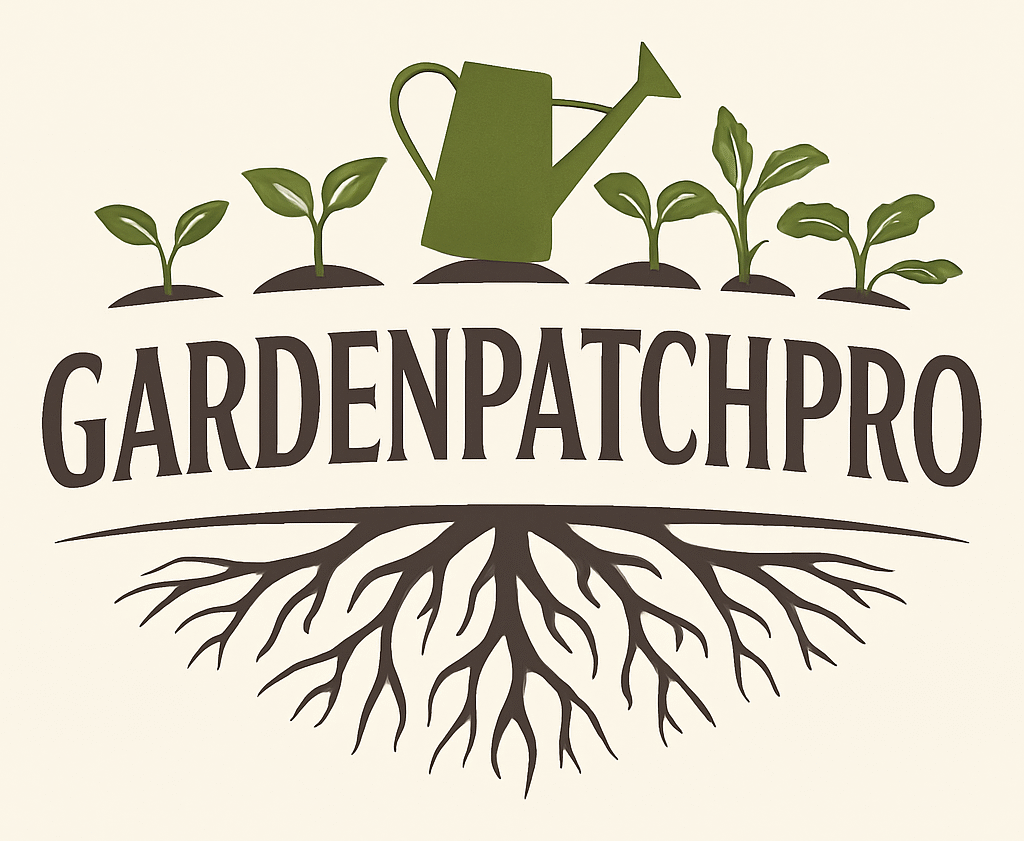13 Garden Fence Ideas to Enhance Privacy and Style
A garden fence can change the look and feel of an outdoor space while also serving important purposes like privacy and security. Many people consider adding a fence to define their garden area or add style.
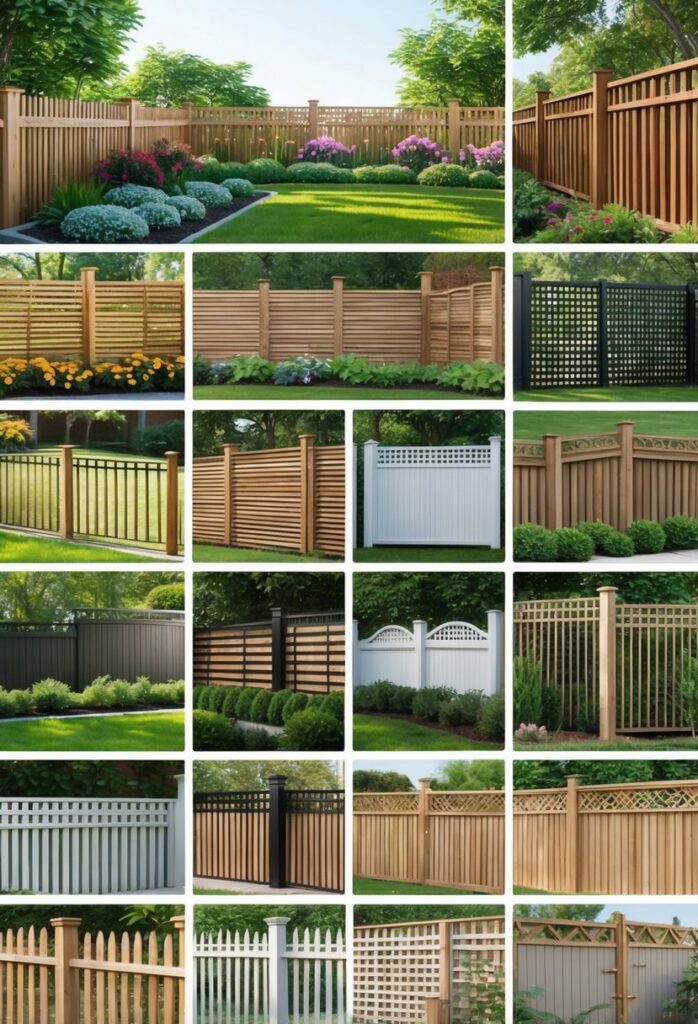
Choosing the right garden fence helps balance function and design to suit different needs and budgets. This article explores 13 ideas that offer a mix of options for various tastes and uses.
1) Rustic split-rail wooden fence
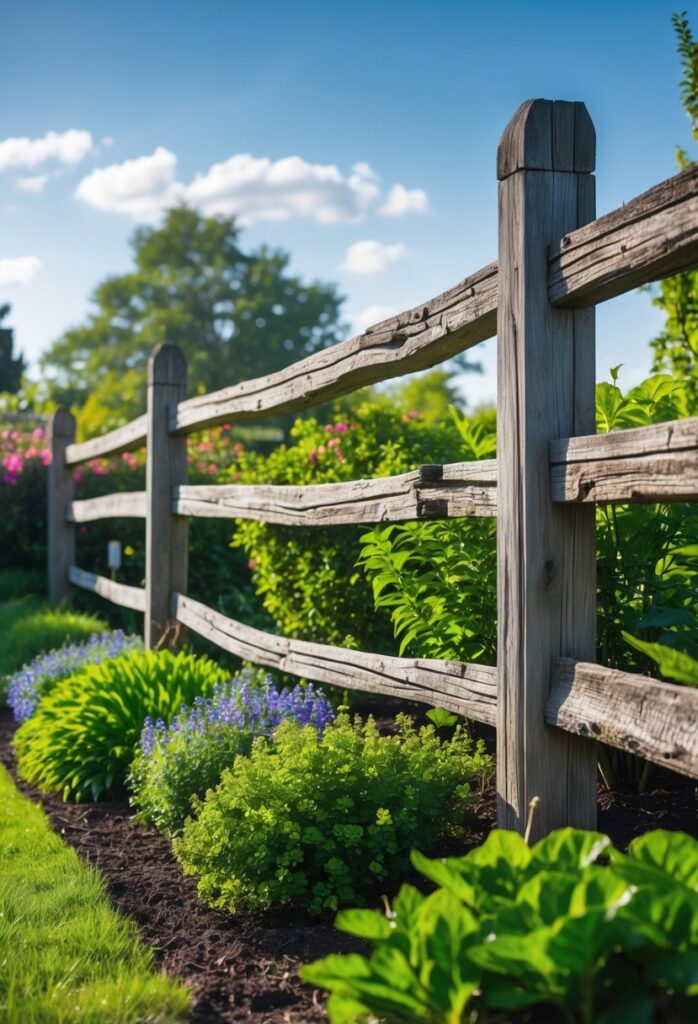
A rustic split-rail wooden fence adds a natural, timeless look to any garden. It typically consists of horizontal wood rails resting in notches of vertical posts. This simple design creates an open feel while marking property lines or garden borders clearly.
The wood texture brings warmth and fits well with various outdoor styles. It works especially well in gardens that focus on natural, countryside charm. The fence lets plants and views remain visible, making it both functional and decorative.
Split-rail fences come in different configurations, usually two or three rails high. They can be made from wood types like cedar or pine, which handle weather fairly well. The fence is easy to install and maintain but may need occasional treatment to resist decay.
For those looking for more durability, composite versions offer similar rustic appeal with better resistance to pests and weather. This makes them a practical choice for longer-lasting fences. Overall, the rustic split-rail wooden fence blends well with garden landscapes and adds simple, classic charm.
More ideas about rustic split-rail fences can be found at 30 Split Rail Fence Ideas For Rustic Outdoor Boundaries.
2) Modern horizontal slatted wood fence
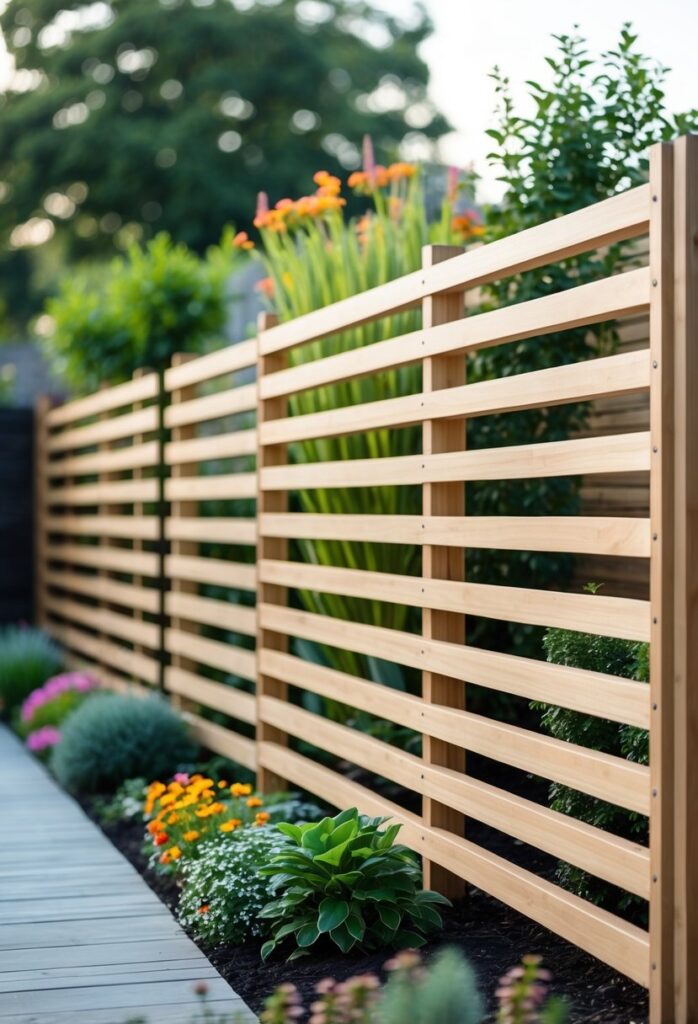
A modern horizontal slatted wood fence gives a clean and organized look to any garden. It uses wood planks placed horizontally with even gaps between them. This design helps create privacy while still allowing light and air to pass through.
The choice of wood affects both appearance and durability. Cedar and pine are popular options because they are natural and resist weather well. The wood can be left natural or stained to match the garden’s style.
This fence style fits well in modern and minimalist gardens. It can add warmth and texture without looking heavy or bulky. Combining different wood tones, like light cedar with a darker frame, creates visual interest.
Building a horizontal slat fence is a project some homeowners take on themselves. Using treated lumber and following design plans can result in a sturdy and stylish boundary. For more ideas and options, see this collection of modern horizontal fence designs.
3) Wrought iron decorative fence
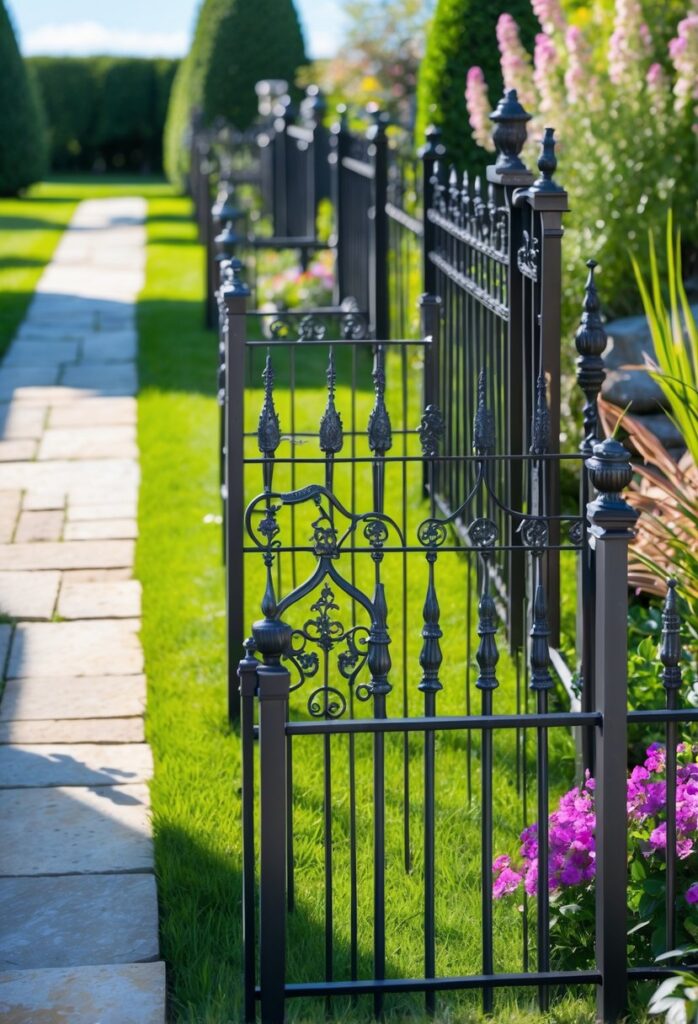
Wrought iron fences offer a strong and lasting option for garden boundaries. They are made from solid metal, which resists damage from weather and wear. This durability makes them a practical choice for long-term use.
The designs are often intricate, with patterns like curls, twists, or finials. These details add a classic, elegant look to any garden space. Popular decorative elements include fleur-de-lis finials, which bring a historic and refined touch.
Besides beauty, wrought iron fences provide good security. The metal is hard to break, keeping animals and intruders out. Many homeowners choose wrought iron to combine safety with style.
Wrought iron fences blend well with natural surroundings. They often support climbing plants like roses, creating a pleasing contrast between metal and flowers. This can enhance the garden’s overall appearance.
For more ideas on how decorative wrought iron fences can improve a garden, see this page on creative wrought iron fence ideas.
4) Living green wall fence with climbing plants
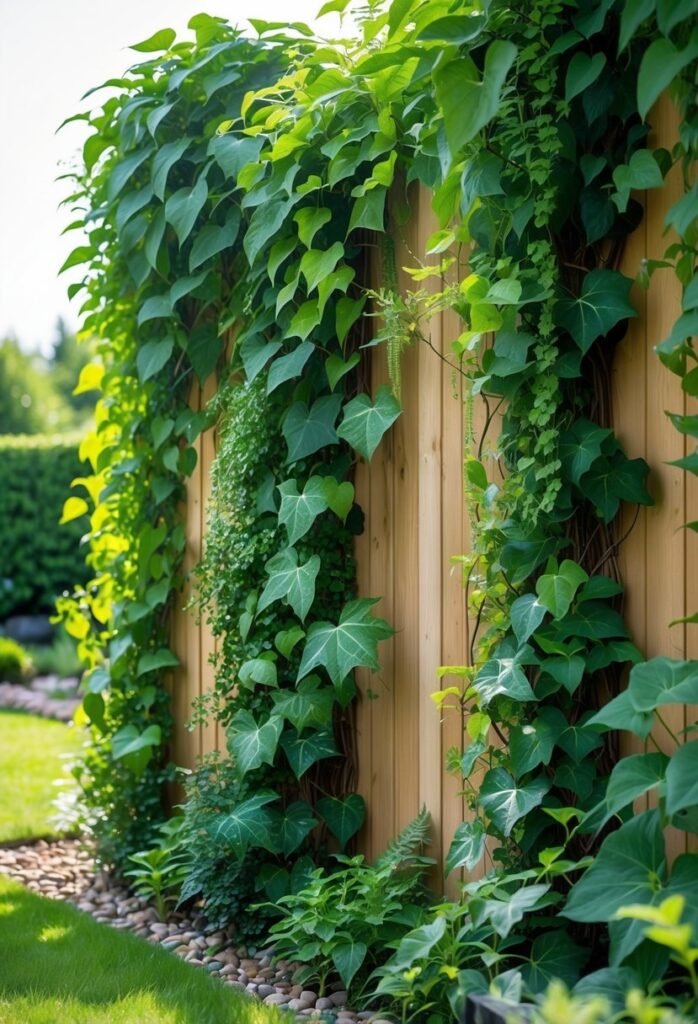
A living green wall fence uses climbing plants to cover a fence with natural greenery. These plants grow up and along the fence, creating a lush, green barrier. It adds privacy without the need for solid materials like wood or metal.
Climbing plants can provide year-round interest, especially if evergreen varieties are chosen. These hold their leaves through winter, keeping the fence green and attractive at all times. Many climbers also produce flowers that add color and attract pollinators.
This option requires some maintenance, like pruning and training the plants to grow where desired. However, it generally needs less upkeep than traditional fences. Climbing plants can also improve air quality and support local wildlife.
Popular choices for a living fence include clematis, climbing roses, and fast-growing vines. Gardeners should select plants that suit their climate and sun exposure. For ideas on which plants work well for living fences, see 21 stunning climbing plants that can replace a traditional fence.
5) Bamboo privacy fence
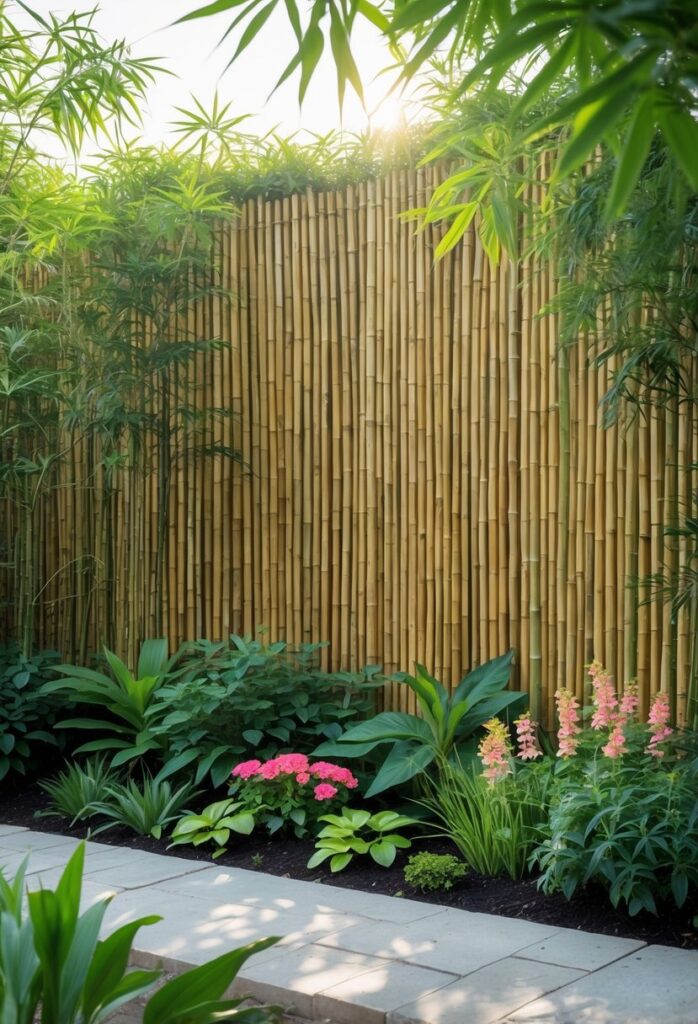
A bamboo privacy fence offers a natural way to block views and add privacy to a garden. It creates a peaceful backdrop with its simple, green look that fits many garden styles.
Bamboo grows quickly and is eco-friendly. Using bamboo for fencing is both sustainable and stylish. It can create a tropical or modern feel depending on the design chosen.
Bamboo fences come in many forms. They can be tall and dense for full privacy or arranged more loosely for a decorative effect. Adding lighting to bamboo fences can also enhance the space, making the garden feel inviting at night.
This type of fence is durable if properly maintained. Bamboo resists weather well but needs occasional treatment to prevent pests and rot. Its unique texture adds character that other fences often lack.
For those looking to transform their yard with a natural, elegant barrier, a bamboo privacy fence offers a reliable and attractive option. It blends function with beauty to improve outdoor spaces.
6) Wire mesh garden fence for pets

A wire mesh garden fence is a practical way to keep pets safe and secure. It prevents pets from running off while allowing good visibility and airflow. This type of fence is often used for dogs because it is strong and durable.
The mesh comes in different sizes and thicknesses. Smaller gaps stop smaller animals from escaping or entering. Thicker wire adds strength and can handle pets that may push or scratch at the fence.
Combining wood posts with wire mesh creates a sturdy structure. The wood adds support and a natural look, while the wire mesh provides a secure barrier. This style suits many backyard designs, including rustic and modern.
Installing weatherproof clips and powder-coated steel posts helps maintain the fence over time. These materials resist rust and wear, which is important for outdoor use. A well-built wire mesh fence can last for years with minimal upkeep.
For ideas and instructions on creating wire mesh fences for pets, explore options like wire fencing for dogs and wood fence with wire mesh.
7) Trellis fence for vine support
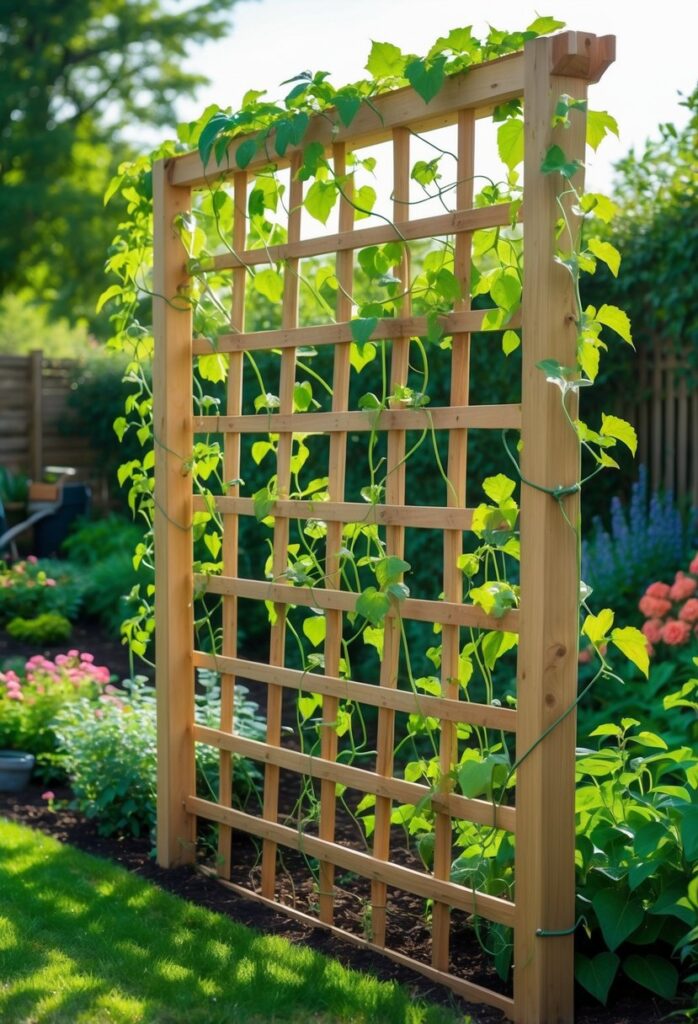
A trellis fence is a practical way to support climbing vines. It allows plants to grow upward, saving space and creating a natural wall of greenery.
Trellises come in many styles, from simple lattice panels to expandable wooden designs. These structures can be attached directly to existing fences or used as standalone features.
Using a trellis fence not only helps vines grow but also adds privacy to the garden. It can turn a plain fence into a more attractive garden element.
Vines like clematis, jasmine, and flowering varieties work well with trellises. They cling easily and create a lush, colorful display when fully grown.
Expandable trellis fences offer flexibility. They can be adjusted to fit different spaces and grow with the plants over time.
Lightweight, budget-friendly lattice panels are perfect for beginners or those wanting a quick support system. They encourage healthy vine growth without taking much effort.
More ideas and options for trellis fences can be found in this collection of best expandable trellis fences for vines.
8) Upcycled pallet wood fence
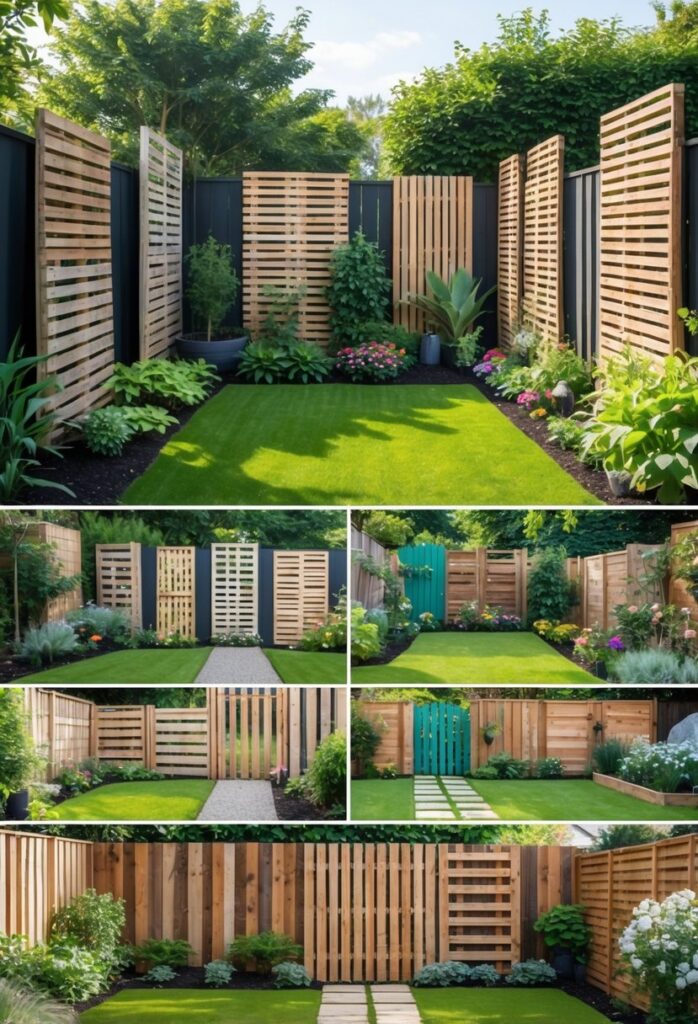
An upcycled pallet wood fence is a practical choice for gardeners who want an affordable and eco-friendly option. Using wood pallets that would otherwise be discarded helps reduce waste. It also saves money compared to buying new lumber.
The fence can be built quickly since pallets come in ready-made panels. These panels can be arranged side by side or stacked for height. The design can be simple or decorative, depending on the look desired.
Pallet wood fences provide privacy and define garden borders well. They can be painted or stained to match the yard’s style. Adding plants or lighting to the fence further enhances its charm.
This fence option is durable but may need occasional maintenance. Pallets should be inspected for quality before use to avoid broken or weak boards. Overall, repurposing pallet wood is a smart choice for a budget-friendly garden fence.
More ideas on making a pallet fence are available at 24 Creative Pallet Fence Ideas for Budget-Friendly Outdoor Spaces.
9) Classic white picket fence
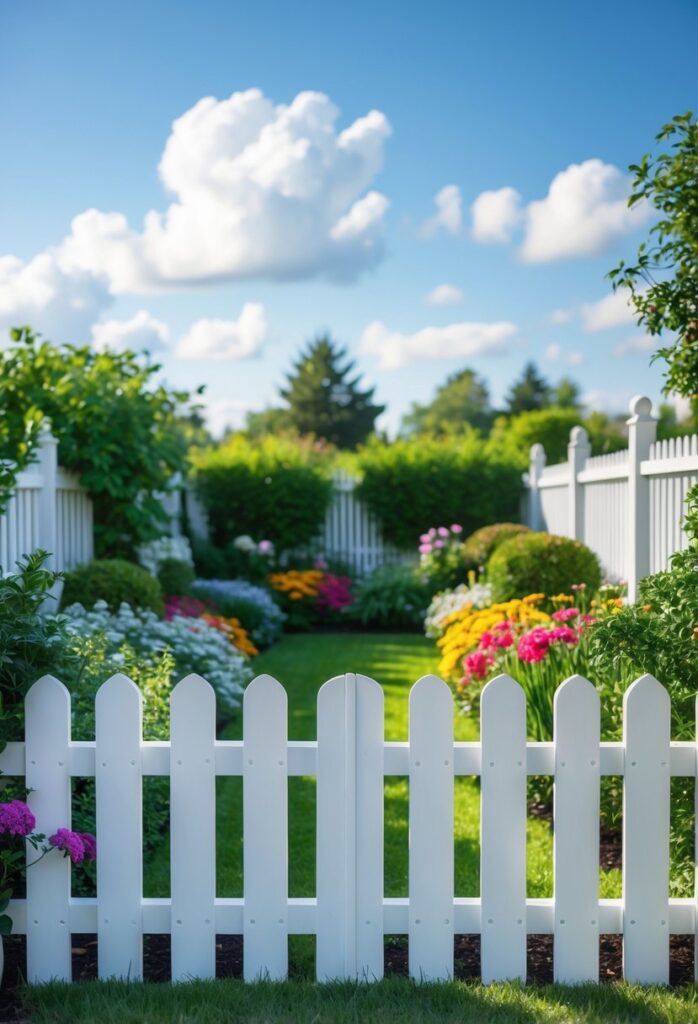
A classic white picket fence remains a popular choice for many gardens. It offers a clean, simple look that frames outdoor spaces without blocking views. This style adds a traditional and timeless feel to any home.
White picket fences come in different styles, such as dog ear or Gothic point. They can be made from wood or low-maintenance materials like PVC vinyl. This flexibility allows homeowners to match the fence to their garden’s style and climate.
Planting flowers along the base of the fence enhances its charm. Climbing roses or colorful blooms can add visual appeal and soften the fence’s lines. This combination creates a welcoming and inviting atmosphere in the yard.
In addition to aesthetics, a white picket fence helps define property boundaries. It keeps pets and children safely inside while maintaining an open, friendly look. Many gardeners use them to balance function and curb appeal.
For more ideas on decorating and choosing a style, see white picket fence landscaping ideas.
10) Steel garden fence with powder coating
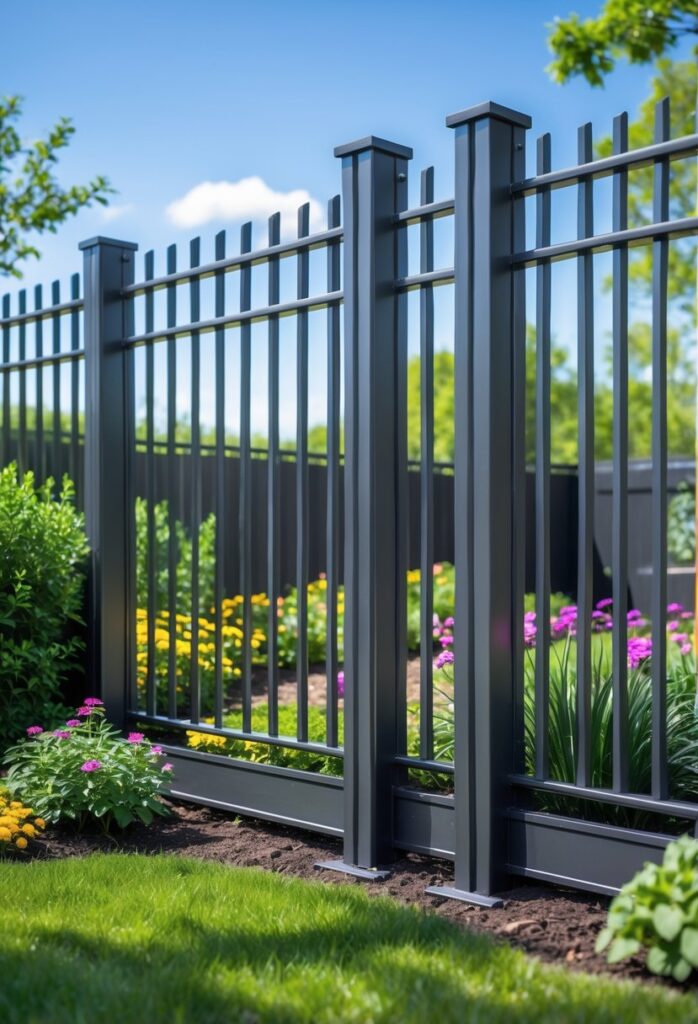
A steel garden fence with powder coating offers strong protection against rust and weather damage. The powder coating creates a hard finish that lasts longer than paint. This makes it a good choice for outdoor use.
The finish is smooth and even, which improves the fence’s look. It also requires less maintenance over time. People can choose from many colors and styles to match their garden.
Installing a powder-coated steel fence usually takes less time because the material is durable and easy to handle. It resists scratches and chips better than other coatings.
This type of fence provides security while keeping a clean, modern appearance. It fits well with many garden designs, from sleek and minimalist to more decorative styles.
For more details about installation and benefits, see the Comprehensive Guide to Installing Powder Coated Steel Fences.
11) Decorative metal scrollwork fence

A decorative metal scrollwork fence adds both style and function to a garden. It often features curved patterns that resemble vines or flowers, giving a classic and elegant look. These designs make the fence more than just a boundary; they create visual interest.
The metal used is usually iron or steel, which provides durability and strength. This type of fence can withstand weather while maintaining its design quality over time. It also offers moderate security without feeling heavy or closed off.
Scrollwork fences work well in many garden styles. They can match traditional homes or add charm to modern landscapes. Plus, they allow visibility into the garden, keeping the space open and inviting.
Adding floral motifs or intricate scroll patterns can enhance the garden’s theme. These artistic fences often become a focal point at entrances or along garden paths. People can find various ideas for decorative metal scrollwork fences to suit their personal taste at sites like Creative Ideas for Metal Fencing.
12) Natural stone pillar fence with wood panels
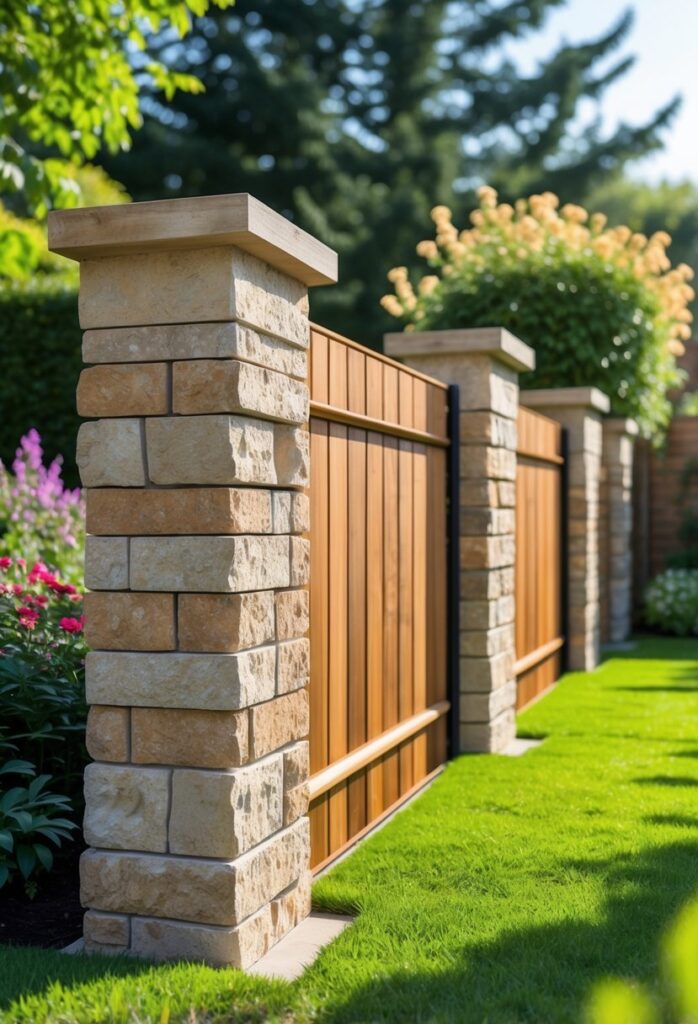
This fence style combines the strength and beauty of stone pillars with the warmth of wood panels. The stone pillars provide solid support and a timeless look. They also break up the wood sections, adding visual interest.
Wood panels fit neatly between the pillars, offering privacy and a natural feel. Using sustainably sourced wood can make the fence more eco-friendly. The wood’s texture contrasts well with the rough stone surface.
Stone pillars are durable and need little maintenance. Wood panels may require occasional sealing or staining to protect them from weather damage. This mix of materials suits many garden styles, from rustic to modern.
The design creates a balanced, sturdy fence that blends well with natural landscapes. Ideas for this style can be found on sites featuring stone pillar garden fencing and mixed stone and wood fences.
13) Garden fence with integrated planter boxes

A garden fence with integrated planter boxes combines function and style. It allows plants to grow directly on or next to the fence, saving space. This design is ideal for small yards or gardens that need more greenery without extra ground area.
The planter boxes can be attached to the fence or built into it. Materials like wood or metal work well for durability. Some designs include trellises for climbing plants, adding height and privacy.
This fence type helps create a natural barrier. It can hide unsightly areas while displaying flowers or vegetables. The planter boxes also make watering and care easier as the plants are centralized.
Building such fences can be a DIY project with basic lumber and simple tools. Adjustable and removable panels offer flexibility. For ideas and inspiration, exploring examples of functional privacy fence planter boxes is useful. More details can be found at beautiful functional privacy fence planter boxes ideas.
Choosing the Right Materials for Your Garden Fence
Selecting the right material affects the fence’s lifespan, upkeep, look, and environmental impact. Careful attention to these factors helps match the fence to specific needs and conditions in the garden.
Assessing Durability and Maintenance
Durability depends on the material’s resistance to weather, pests, and wear. Wood offers natural beauty but requires regular sealing or painting to prevent rot and insect damage. Vinyl and composite fences resist moisture and pests well and need less upkeep but may be pricier upfront.
Metal fences, like aluminum or steel, provide strong, long-lasting options but may need rust protection in humid climates. Maintenance also involves cleaning and occasional repairs. Considering these factors helps avoid costly replacements and extensive labor over time.
Considering Eco-Friendly Options
Eco-friendly fencing materials include sustainably harvested wood, recycled metal, and composite fences made from recycled plastics. These choices reduce waste and environmental harm.
They often last longer and need less chemical treatment. Bamboo is a fast-growing alternative that offers natural strength and appeal. Choosing such materials supports sustainability while still meeting durability and style needs. More detailed ideas are available in guides on garden fence materials.
Enhancing Privacy and Style
Creating a garden fence that combines privacy with visual appeal requires thoughtful choices. Using natural elements alongside the structure adds depth and softness, while careful design helps the fence fit seamlessly into the overall garden look.
Incorporating Plants and Greenery
Adding plants to a garden fence enhances both privacy and style. Climbing vines like clematis, ivy, or wisteria can grow on trellises attached to the fence. This softens the hard lines of the fence and increases coverage without blocking light completely.
Potted plants and hanging baskets also add layers of texture and color. Evergreen shrubs planted along the base provide year-round screening. These plants can turn a simple fence into a green wall that blends privacy with natural beauty.
Maintenance is key. Choosing plants suited to the climate and sunlight ensures they thrive. Combining different types of greenery can create a balanced, attractive look that changes with the seasons.
Blending Fences With Garden Landscapes
Selecting a fence that matches the garden’s style is essential for harmony. Wooden fences can complement rustic or cottage gardens, while metal or glass fences suit modern designs. The color and finish of the fence should echo other garden features like pathways, furniture, or flower beds.
Using materials that echo natural tones or textures helps the fence disappear into the surroundings. For example, weathered wood blends well with wildflower areas, while smooth panels complement trimmed lawns.
Adding features like built-in planters, lighting, or decorative posts enhances the fence’s role as part of the garden, not just a barrier. Thoughtful placement around flower beds or seating areas creates visual flow and defines spaces clearly.
For more ideas on blending fences with landscapes, see 25 Garden Fence Ideas to Elevate Your Outdoor Privacy and Style.
Frequently Asked Questions
Many garden fence ideas focus on balancing cost, effectiveness, and style. Options range from simple wood designs to natural living fences, and it’s important to know how to build, protect, and customize these fences, especially for vegetable gardens.
How can I build a DIY garden fence on a budget?
Using reclaimed wood or pallets is a popular budget-friendly choice. A rustic split-rail wooden fence can be built with materials that are easy to find and assemble. Simple wire mesh combined with wooden posts can also create a durable barrier without high costs.
What are some cost-effective ideas for fencing a vegetable garden?
For vegetable gardens, a practical method is using chicken wire or hardware cloth stretched tightly over wooden stakes. Bamboo fences can be inexpensive and provide decent privacy while keeping pests out. Living green wall fences with climbing plants add both protection and beauty without heavy material costs.
Are there any garden fence designs that can keep animals out effectively?
Fences at least 6 feet tall usually deter deer. Wrought iron fences provide sturdy barriers for larger animals. For rabbits and smaller pests, buried wire mesh or fine netting around the base helps prevent burrowing. Combining a physical barrier with natural deterrents like thorny plants is effective.
What are the best small vegetable garden fencing solutions?
Low-profile fences like short wooden slats or bamboo screens save space while defining garden boundaries. Modern horizontal slatted wood fences work well in small areas, offering privacy without feeling cramped. Stick fencing made from local branches can frame small patches nicely.
How to incorporate a gate into a vegetable garden fence design?
Gates should match the fence style for a unified look. Hinged wooden gates with simple latches are easy to install and maintain. For secure gardens, metal frames with wire mesh gates add strength. Position gates for easy access without disrupting fence continuity.
What are some creative and inexpensive garden fence ideas?
Living fences with climbing vines or plants provide natural screening and grow over time. Chain-link fences decorated with plants combine affordability and style. Pallet fences can be painted or arranged in patterns for extra charm at low cost. Combining materials can enhance design while saving money.
For more ideas, see 13 garden fence ideas for privacy, protection, and style.
